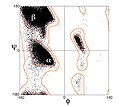Ramachandran plot


In
Uses
A Ramachandran plot can be used in two somewhat different ways. One is to show in theory which values, or
Amino-acid preferences
One might expect that larger side chains would result in more restrictions and consequently a smaller allowable region in the Ramachandran plot, but the effect of side chains is small.[5] In practice, the major effect seen is that of the presence or absence of the methylene group at Cβ.[5] Glycine has only a hydrogen atom for its side chain, with a much smaller van der Waals radius than the CH3, CH2, or CH group that starts the side chain of all other amino acids. Hence it is least restricted, and this is apparent in the Ramachandran plot for glycine (see Gly plot in gallery) for which the allowable area is considerably larger. In contrast, the Ramachandran plot for proline, with its 5-membered-ring side chain connecting Cα to backbone N, shows a limited number of possible combinations of ψ and φ (see Pro plot in gallery). The residue preceding proline ("pre-proline") also has limited combinations compared to the general case.
More recent updates
The first Ramachandran plot was calculated just after the first protein structure at atomic resolution was determined (myoglobin, in 1960[6]), although the conclusions were based on small-molecule crystallography of short peptides. Now, many decades later, there are tens of thousands of high-resolution protein structures determined by X-ray crystallography and deposited in the Protein Data Bank (PDB). Many studies have taken advantage of this data to produce more detailed and accurate φ,ψ plots (e.g., Morris et al. 1992;[7] Kleywegt & Jones 1996;[8] Hooft et al. 1997;[9] Hovmöller et al. 2002;[10] Lovell et al. 2003;[11] Anderson et al. 2005.[12] Ting et al. 2010[13]).
The four figures below show the datapoints from a large set of high-resolution structures and contours for favored and for allowed conformational regions for the general case (all amino acids except Gly, Pro, and pre-Pro), for Gly, and for Pro.[11] The most common regions are labeled: α for α helix, Lα for left-handed helix, β for β-sheet, and ppII for polyproline II. Such a clustering is alternatively described in the ABEGO system, where each letter stands for α (and 310) helix, right-handed β sheets (and extended structures), left-handed helixes, left-handed sheets, and finally unplottable cis peptide bonds sometimes seen with proline; it has been used in the classification of motifs[14] and more recently for designing proteins.[15]
While the Ramachandran plot has been a textbook resource for explaining the structural behavior of peptide bond, an exhaustive exploration of how a peptide behaves in every region of the Ramachandran plot was only recently published (Mannige 2017[16]).
The
Related conventions
One can also plot the dihedral angles in polysaccharides (e.g. with CARP).[19]
Gallery
-
Ramachandran plot for the general case; data from Lovell 2003
-
Ramachandran plot for Glycine
-
Ramachandran plot for Proline
-
Ramachandran plot for pre-Proline
Software
- Web-based Structural Analysis tool for any uploaded PDB file, producing Ramachandran plots, computing dihedral angles and extracting sequence from PDB
- Web-based tool showing Ramachandran plot of any PDB entry
- MolProbity web service that produces Ramachandran plots and other validation of any PDB-format file
- SAVES (Structure Analysis and Verification) — uses WHATCHECK, PROCHECK, and does its own internal Ramachandran Plot
- STING
- Pymolwith the DynoPlot extension
- VMD, distributed with dynamic Ramachandran plot plugin
- WHAT CHECK, the stand-alone validation routines from the WHAT IF software
- UCSF Chimera, found under the Model Panel.
- Sirius
- Swiss PDB Viewer
- TALOS
- Zeus molecular viewer — found under "Tools" menu, high quality plots with regional contours
- Procheck
- Neighbor-Dependent and Neighbor-Independent Ramachandran Probability Distributions[13]
- See also PDB for a list of similar software.
References
- PMID 13990617.
- PMID 7020376.
- PMID 14816373.
- PMID 4882249.
- ^ PMID 11389934.
- S2CID 4167651.
- S2CID 940786.
- PMID 8994966.
- PMID 9283757.
- PMID 11976487.
- ^ S2CID 8358424.
- S2CID 17410997.
- ^ PMID 20442867.
- PMID 8568871.
- PMID 26396255.
- PMID 28533975.
- ^ "50th Anniversary of Ramachandran Plots". Professor Laurence A. Moran. Retrieved 17 January 2013.
- ^ "ICBFF-2013". MBU, IISc, Bangalore. Archived from the original on 15 January 2013. Retrieved 28 January 2013.
- PMID 15608187.
Further reading
- Richardson, J.S. (1981). "The Anatomy and Taxonomy of Protein Structure". Anatomy and Taxonomy of Protein Structures. Advances in Protein Chemistry. Vol. 34. pp. 167–339. ]
- Branden, C.-I.; Tooze, J. (1991), Introduction to Protein Structure, Garland Publishing, NY, ISBN 0-8153-0344-0




